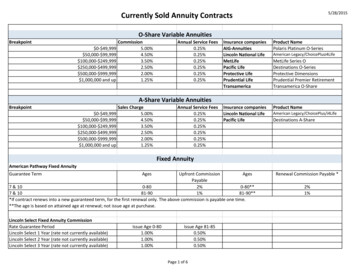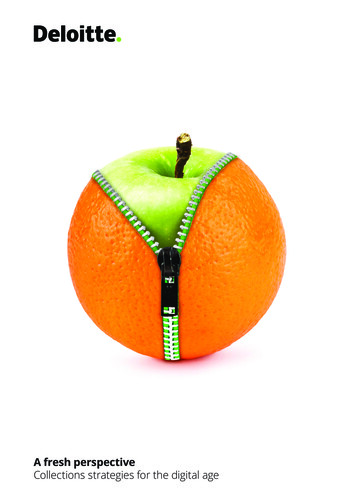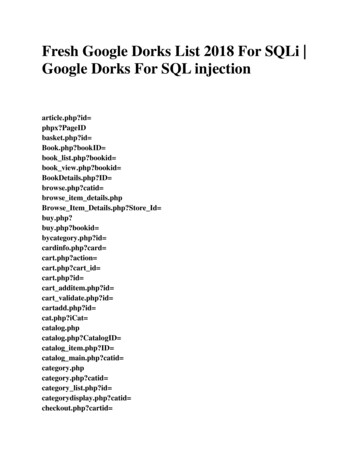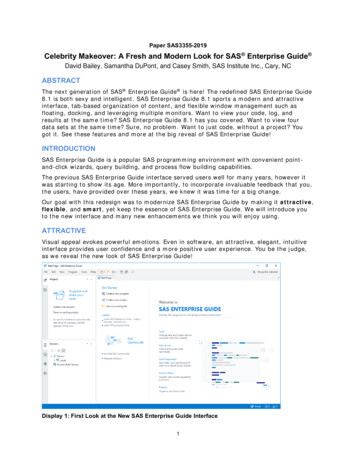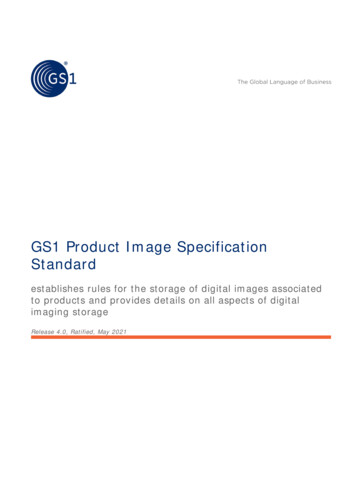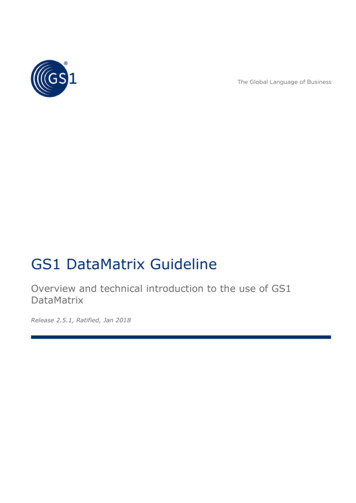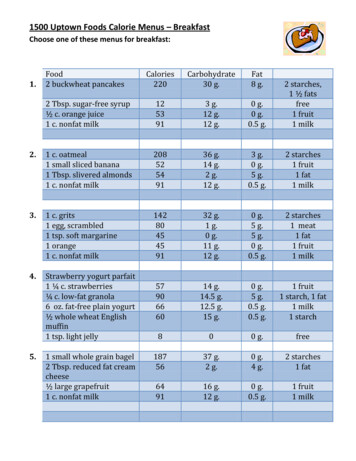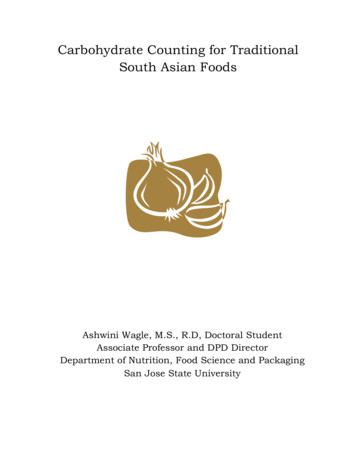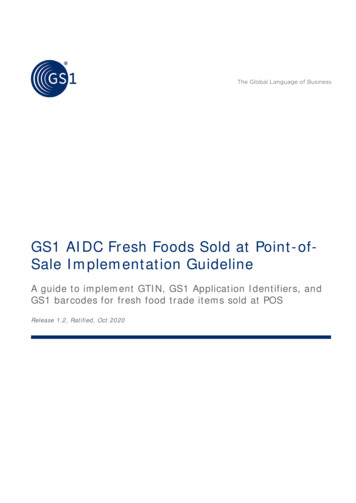
Transcription
GS1 AIDC Fresh Foods Sold at Point-ofSale Implementation GuidelineA guide to implement GTIN, GS1 Application Identifiers, andGS1 barcodes for fresh food trade items sold at POSRelease 1.2, Ratified, Oct 2020
GS1 AIDC Fresh Foods Sold at Point-of-Sale Implementation GuidelineDocument SummaryDocument ItemCurrent ValueDocument NameGS1 AIDC Fresh Foods Sold at Point-of-Sale Implementation GuidelineDocument DateOct 2020Document Version1.2Document IssueDocument StatusRatifiedDocument DescriptionA guide to implement GTIN, GS1 Application Identifiers, and GS1barcodes for fresh food trade items sold at POSContributorsFirst NameLast NameCompanyPatrickArijsCOLRUYT GROUP NVJenniferKeeganWoolworths LimitedAndreasMahringMETRO GroupRobertoOlivaresWoolworths LimitedMagnusStoltICA Sverige ABDieterBeitzCSB System AGThomasBurkeInstitute of Food TechnologistsMakotoAkutagawaGS1 JapanKarenArkesteynGS1 Belgium & LuxembourgJonasBattGS1 SwitzerlandHeideBuhlGS1 GermanyJonasBuskenfriedGS1 SwedenEmanuelaCasaliniGS1 ItalyRamanChhimaGS1 New ZealandLuizCostaGS1 BrasilTimDalyGS1 IrelandOwenDanceGS1 New ZealandPetaDingGS1 UKKlausFoerdererGS1 GermanyJean-ChristopheGilbertGS1 FranceNicoleGolestaniGS1 CanadaMarieHolmGS1 DenmarkRelease 1.2, Ratified, Oct 2020 2020 GS1 AISBLPage 2 of 39
GS1 AIDC Fresh Foods Sold at Point-of-Sale Implementation GuidelineFirst NameLast NameCompanyYoshihikoIwasakiGS1 JapanKimmoKeravuoriGS1 FinlandMadsKibsgaardGS1 DenmarkAlexeyKrotkovGS1 RussiaIldikÃLieberGS1 HungaryDenisO'BrienGS1 IrelandGeoffO'ConnellGS1 UKMichelOttikerGS1 SwitzerlandArunaRavikumarGS1 AustraliaRocioRiveraGS1 MexicoEugenSehorzGS1 AustriaCesarSilvestreGS1 MexicoAndrewSteeleGS1 AustraliaHannaWalczakGS1 PolandMelanieWishartGS1 AustraliaXinMinWuGS1 ChinaRuoyunYanGS1 ChinaStevenKeddieGS1 Global OfficeDanMullenGS1 Global OfficeNeilPiperGS1 Global OfficeGregRoweGS1 Global OfficeJohnRyuGS1 Global OfficeElenaTomanovichGS1 Global OfficeLog of ChangesReleaseDate of ChangeChanged BySummary of Change1.0Aug 2011Mark Frey, Greg RoweInitial publication1.1Sep 2015Alex JohnsonUpdate to GS1 branding1.2Oct 2020Dan MullenWR 20-028 Update to include guidance on use ofGS1 DataMatrix and GS1 QR Code for variablemeasure fresh food items. Clarification of textlayout for easier use of the Guide.Release 1.2, Ratified, Oct 2020 2020 GS1 AISBLPage 3 of 39
GS1 AIDC Fresh Foods Sold at Point-of-Sale Implementation GuidelineDisclaimerGS1 , under its IP Policy, seeks to avoid uncertainty regarding intellectual property claims by requiring the participants inthe Work Group that developed this GS1 AIDC Fresh Foods Sold at Point-of-Sale Implementation Guideline to agreeto grant to GS1 members a royalty-free licence or a RAND licence to Necessary Claims, as that term is defined in the GS1IP Policy. Furthermore, attention is drawn to the possibility that an implementation of one or more features of thisSpecification may be the subject of a patent or other intellectual property right that does not involve a Necessary Claim.Any such patent or other intellectual property right is not subject to the licencing obligations of GS1. Moreover, theagreement to grant licences provided under the GS1 IP Policy does not include IP rights and any claims of third parties whowere not participants in the Work Group.Accordingly, GS1 recommends that any organisation developing an implementation designed to be in conformance with thisSpecification should determine whether there are any patents that may encompass a specific implementation that theorganisation is developing in compliance with the Specification and whether a licence under a patent or other intellectualproperty right is needed. Such a determination of a need for licencing should be made in view of the details of the specificsystem designed by the organisation in consultation with their own patent counsel.THIS DOCUMENT IS PROVIDED “AS IS” WITH NO WARRANTIES WHATSOEVER, INCLUDING ANY WARRANTY OFMERCHANTABILITY, NONINFRINGEMENT, FITNESS FOR PARTICULAR PURPOSE, OR ANY WARRANTY OTHER WISE ARISINGOUT OF THIS SPECIFICATION. GS1 disclaims all liability for any damages arising from use or misuse of this document,whether special, indirect, consequential, or compensatory damages, and including liability for infringement of anyintellectual property rights, relating to use of information in or reliance upon this document.GS1 retains the right to make changes to this document at any time, without notice. GS1 makes no warranty for the use ofthis document and assumes no responsibility for any errors which may appear in the document, nor does it make acommitment to update the information contained herein.GS1 and the GS1 logo are registered trademarks of GS1 AISBL.Release 1.2, Ratified, Oct 2020 2020 GS1 AISBLPage 4 of 39
GS1 AIDC Fresh Foods Sold at Point-of-Sale Implementation GuidelineTable of Contents1Executive summary . 72Introduction . 72.134Purpose and scope of this document . 72.1.1Purpose . 72.1.2Scope . 82.2Who can use this document? . 82.3How do I use the document? . 82.4Important definitions . 8General guidance . 93.1GTIN explanation . 93.2Benefits of implementing GTIN with attribute data . 93.3Migration from RCN to GTIN . 103.4Which barcode can I use?. 103.5Attributes using Application Identifiers (AIs) . 11Implementation guideline for suppliers . 124.1Business process change for variable measure products . 134.1.14.2Fixed measure products . 144.2.15Which barcode do I use for fixed measure items? . 144.3Loose produce trade items . 154.4Supplier readiness checklist . 154.5Scale label readiness . 174.6Scanner readiness . 174.7How to allocate and when to change the GTIN . 174.8How to manage non-POS product that may go to POS . 17Implementation guide for retailers . 185.15.25.3Business process changes . 18Variable measure products . 205.2.1In-store labelled products . 205.2.2Pre-packed / Pre-labelled products . 20Fixed measure products . 205.3.16Which barcode do I use for variable measure items? . 13Which barcode do I use for fixed measure items? . 205.4Loose produce trade items . 205.5Retailer Readiness Checklist . 215.6POS software readiness . 225.7Scanner readiness . 235.8Scale label readiness . 245.9How to allocate and when to change the GTIN . 245.10How to manage Non-POS product that may go to POS . 24Implementation guide for AIDC equipment and software companies . 256.1Scanners. 256.2Label printer equipment (includes printers with or without scales) . 25Release 1.2, Ratified, Oct 2020 2020 GS1 AISBLPage 5 of 39
GS1 AIDC Fresh Foods Sold at Point-of-Sale Implementation Guideline6.37Processing GS1 Application Identifiers (AIs) . 256.3.2Processing key entry of data on labels . 266.3.3Handling master data relationships . 26Appendix . 277.1Fresh foods GTIN Management . 277.2Restricted Circulation Number (RCN) examples . 287.3GS1 URLs for further barcode information . 297.47.58Retailers and software companies at POS . 256.3.1How GS1 DataBar, GS1 QR Code and GS1 DataMatrix can be used - Business case examples. 297.4.1Expiration date management – Stopping a transaction at POS . 297.4.2Automatic markdown . 317.4.3Product recall and traceability at point-of-sale . 317.4.4Product replenishment . 33GS1 barcode samples . 35Glossary. 39Release 1.2, Ratified, Oct 2020 2020 GS1 AISBLPage 6 of 39
GS1 AIDC Fresh Foods Sold at Point-of-Sale Implementation Guideline1Executive summaryThe Food and Agriculture Organisation of the United Nations estimates that every year,approximately one-third of the world’s food supply is lost or wasted!* How can we workto reduce this cost?* The Food and Agriculture Organisation (FAO) of the United Nations, http://www.fao.org/food-loss-andfood-waste/en/The growing sophistication of technology and management systems has led to demands foradditional information to be carried by GS1 barcode symbols and captured at the retail point-of-sale.GS1 DataBar, GS1 DataMatrix and GS1 QR Code provide the path for the fresh food industry torespond to these new requirements.While EAN/UPC barcodes will remain useful for product identification, other GS1 symbols enableexpanded barcode implementation by meeting the objective of identifying small items and carryingmore information than the standards and technology of current EAN/UPC barcodes used on freshfood trade items today. Today, most variable measure products are still labelled with an EAN/UPCbarcode encoding a Restricted Circulation Number (RCN) that is 12 or 13 digits long and containsinformation about the weight or price of the variable measure item. However, an RCN is, at bestcase, unique at a national level. An RCN is not a GTIN (Global Trade Item Number). RCNs are GS1identification numbers used for special applications in restricted environments, defined by the localGS1 Member Organisation (e.g., restricted within a country, company, or industry). They areallocated by GS1 for either internal use by companies or to GS1 Member Organisations forassignment based on business needs in their country (e.g., variable measure trade itemidentification, coupons). For more about RCN see 7.2More and more, variable measure items are being labelled with a GS1 barcode symbol encoding theGTIN, the weight of the product and other optional attributes. Migrating from RCNs to GTIN willenable retailers and suppliers to expand their business functionalities of the centre store to theperimeter and enable new financial opportunities within fresh food departments.In 2014 GS1 DataBar became an open symbology and all scanning environments must beable to read these symbols. In 2019 GS1 DataMatrix and GS1 QR Code were also madeavailable as data carriers for variable measure fresh foods. The decision to use EAN/UPC,or GS1 DataBar on variable measure products is left to the brand owner or bi-lateral usebetween trading partners. GS1 QR Code or GS1 DataMatrix on variable measure productscan be done with a bi-lateral agreement between trading partners.GS1 DataBar, GS1 DataMatrix, and GS1 QR Code can encode brand identification and additionaldata on fresh food products. This means Consumer and Food Safety programs can be instituted atthe register and on the consumer receipt. Additional benefits from implementing GS1 DataBar forfixed measure and variable measure fresh foods; Automatic Markdowns at point-of-sale (POS),Expiration Date Management, Traceability to the POS, and Category Management. Similarly, forvariable measure fresh foods, GS1 2D symbols can support these applications.This Implementation Guide is specifically focused on process changes for fresh food point-of-saleapplications for variable measure, fixed measure, as well as, loose produce trade items. It willprovide retailers, suppliers and solution providers the necessary information to implement GTIN,GS1 Application Identifiers via GS1 DataBar, GS1 DataMatrix, or GS1 QR Code Symbols at point-ofsale. It will point to Fresh Foods Standards in the GS1 General Specifications.2Introduction2.1Purpose and scope of this document2.1.1PurposeThis document describes the Business Process Changes needed to encode and decode GTIN and/oradditional data using GS1 DataBar barcodes for variable measure, fixed measure and loose producefresh food trade items scanned at retail Point-of-Sale. It also describes the Business ProcessRelease 1.2, Ratified, Oct 2020 2020 GS1 AISBLPage 7 of 39
GS1 AIDC Fresh Foods Sold at Point-of-Sale Implementation GuidelineChanges needed to encode and decode GTIN and additional data using GS1 DataMatrix or GS1 QRCode symbols for variable measure fresh foods.Fresh Foods includes product categories such as: fruits, vegetables, meats, seafood, bakery andready-to-serve food such as cheeses, cold cooked or cured meats, and salad, etc.2.1.2ScopeThis document outlines what retailers and suppliers need to do in order to identify fresh food itemsat Retail POS and apply the corresponding GS1 barcodes. Specifically, it will cover what is requiredto; Move from the use of traditional Restricted Circulation Numbers (RCNs) such as Prefix 02, 20-29,to Global Trade Item Number (GTIN) and attribute information using GS1 Application Identifiers(AIs) for Variable Measure Trade Items. Apply GS1 Application Identifiers (AIs) to existing Fresh Food Fixed Measure Trade Items. Identify and label loose produce items with a GS1 approved POS data carrier (i.e., barcodesymbol)In order to migrate to GTIN identification, or to apply additional information to products at retailPOS, implementation of GS1 DataBar, GS1 DataMatrix, or GS1 QR Code symbols will be required.2.2Who can use this document?This is a practical guide for retailers, suppliers and solution providers to understand businessopportunities, process changes and requirements needed to implement GTIN, GS1 ApplicationIdentifiers, GS1 DataBar, GS1 DataMatrix, GS1 QR Code and EAN/UPC symbols at point-of-sale ontheir fresh food trade items.2.3How do I use the document?All readers are advised to read section 3 for general guidance.New Users:If GS1 standards are new to your company, please contact your local GS1 Member Organisation(www.gs1.org/contact).Suppliers:Read section 4 for Business Process changes required to implement GTIN, GS1 ApplicationIdentifiers and relevant GS1 barcodes at point-of-sale.Retailers:Read section 5 for Business Process changes required to implement GTIN, GS1 ApplicationIdentifiers and relevant GS1 barcodes at point-of-sale.AIDC Equipment and Software Companies:Read section 6 for requirements to implement GTIN, GS1 Application Identifiers and relevant GS1barcodes at point-of-sale.2.4Important definitions Fixed measure trade item - An item always produced in the same pre-defined version (e.g.,type, size, weight, contents, design) that may be sold at any point in the supply chain. Loose produce trade items - Are fruits and vegetables which are delivered to the store loose,in boxes or cases, and then put into a bag or selected individually by the customer for purchase. Variable measure trade item - A trade item which may be traded without a pre-definedmeasure, such as its weight or length.Release 1.2, Ratified, Oct 2020 2020 GS1 AISBLPage 8 of 39
GS1 AIDC Fresh Foods Sold at Point-of-Sale Implementation Guideline3General guidance3.1GTIN explanationThe Global Trade Item Number (GTIN) is the GS1 standard for the unique identification of all tradeitems (consumer units and trade units), including fresh foods. The GTIN supports trade itemidentification for Business to Business (B2B) and Business to Consumer (B2C) processes. The GTINis a GS1 key with a specific structure and allocation rules to assure global uniqueness. The GS1General Specifications prescribe the specifications for the GTIN.The figure below gives an overview of the GTINs that are used for labelling fresh foods. All parties inthe process should be able to process these variants of the GTIN.Figure 3-1 GTIN formats for use at POSGTINGTIN formatGTIN-8N7 CGTIN-12N11 CGTIN-13N12 CN – numeric digitC – check digitWhen any of these GTINs are encoded in a data carrier (i.e. barcode symbol) that encode a fixedlength data string of 14-digits, GTINs with less than 14-digits in length will add leading zeroes tocreate a 14-digit number. The leading zeroes simply act as filler characters. The presence or lack ofthese leading zeroes does not change the GTIN. These series of GTINs may be stored with orwithout leading zeroes in the same database field, depending on the requirements of theapplication.How Global Trade Item Numbers (GTIN) wor
GS1 , under its IP Policy, seeks to avoid uncertainty regarding intellectual property claims by requiring the participants in the Work Group that developed this GS1 AIDC Fresh Foods Sold at Point -of-Sale Implementation Guideline to agree to grant to GS1 members a royalty-free licence or a RAND licence to Necessary Claims, as that term is defined in the GS1
